Top 10 Must-Try Dishes in Mongolia: A Culinary Overview
Mongolian cuisine, with its rich tapestry of flavors and deep cultural roots, beckons adventurous food enthusiasts and travelers alike to embark on a culinary journey unlike any other. Nestled between Russia and China, Mongolia's gastronomy reflects centuries of nomadic traditions influenced by its rugged landscapes and harsh climate. From hearty meat dishes cooked over hot stones to delicate dairy products that sustain the nomadic lifestyle, Mongolian food is a testament to resilience and resourcefulness.
As global interest in diverse culinary experiences continues to grow, Mongolia emerges as a hidden gem for food explorers seeking authenticity and adventure. Beyond its famous landscapes of vast steppes and dramatic mountains, Mongolia's culinary heritage offers a taste of history and tradition, served with warm hospitality that embodies the nomadic spirit. This article delves deep into the heart of Mongolian cuisine, unveiling must-try dishes that define its culinary landscape and cultural identity.
Mongolia
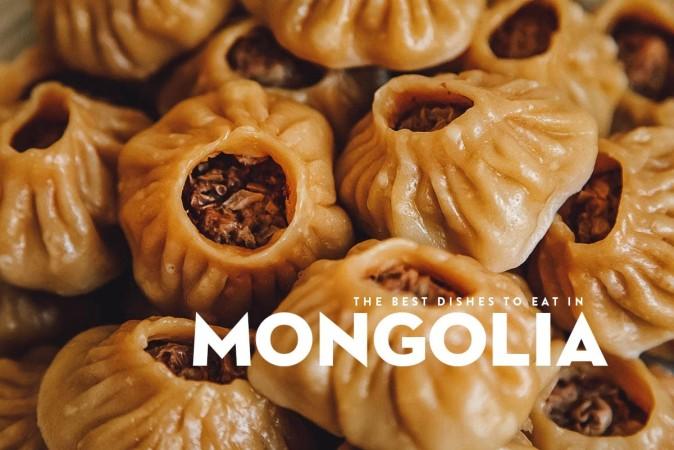
Overview of Mongolian Culinary Heritage
Mongolian cuisine is intricately woven into the fabric of its nomadic lifestyle, shaped by the country's geographical diversity and nomadic history spanning millennia. Traditionally, Mongolian food revolves around meat, particularly mutton and beef, owing to the abundance of livestock grazing freely across the steppes. This reliance on meat as a staple is complemented by dairy products such as yogurt, cheese, and the iconic airag—fermented mare's milk, revered for its nutritional benefits and symbolic importance in Mongolian culture.
Cooking methods in Mongolia are as robust as the landscape itself. The traditional Khorkhog exemplifies this, where chunks of meat are slow-cooked with hot stones, infusing a smoky essence into the stew. Similarly, Buuz and Khuushuur showcase Mongolian ingenuity, with the former being delicate steamed dumplings filled with savory meat and spices, and the latter fried meat pies enjoyed during festive occasions and daily meals alike.
In exploring Mongolian cuisine, you will discover not just a variety of dishes but a profound connection to nature and community. Each meal tells a story of survival and adaptation, passed down through generations of nomads who have mastered the art of living off the land. As Mongolia opens its doors to global travelers, its culinary treasures await discovery, promising a sensory journey that transcends taste to evoke the spirit of the nomadic Mongolian soul.
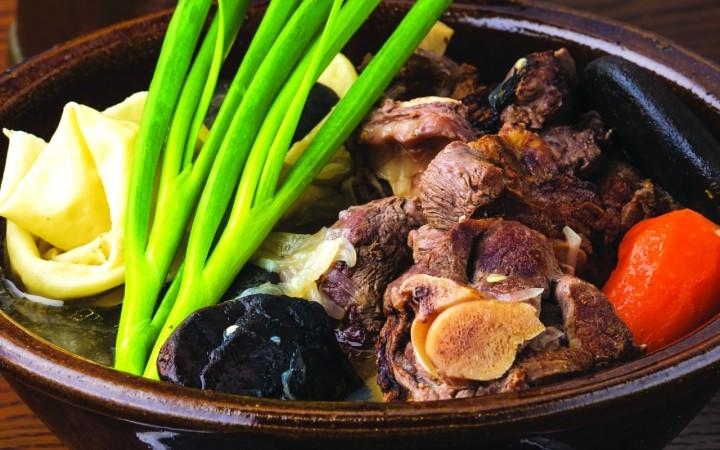
Mongolian Khorkhog - © gather
Top 10 Must-Try Mongolian Dishes
Mongolian cuisine offers a tantalizing array of dishes that capture the essence of its nomadic heritage and rugged landscapes. From savory dumplings to hearty stews cooked with hot stones, each dish is a testament to Mongolia's rich culinary traditions and resourceful cooking methods.
Traditional Mongolian Dishes
Buuz
Buuz, Mongolia's beloved steamed dumplings, are a culinary delight enjoyed across the country. These delicate pockets of dough are typically filled with minced meat—often mutton or beef—mixed with onions, garlic, and a blend of local spices. The dumplings are then steamed, resulting in a tender, flavorful bite that encapsulates the essence of Mongolian comfort food.
Khuushuur
Khuushuur are savory fried pastries filled with minced meat, usually lamb or beef, seasoned with onions and spices. These crescent-shaped delights are fried until golden brown, creating a crispy exterior that gives way to a juicy and aromatic filling. Khuushuur are a staple during festive celebrations and nomadic gatherings, cherished for their hearty flavors and satisfying crunch.
Khorkhog
Khorkhog embodies the rustic essence of Mongolian cuisine, where meat—typically mutton—is cooked slowly with hot stones. The stones impart a smoky flavor to the stew, enhancing the rich, meaty broth infused with vegetables like carrots and potatoes. This traditional dish not only nourishes but also serves as a communal experience, often enjoyed during gatherings around the campfire.
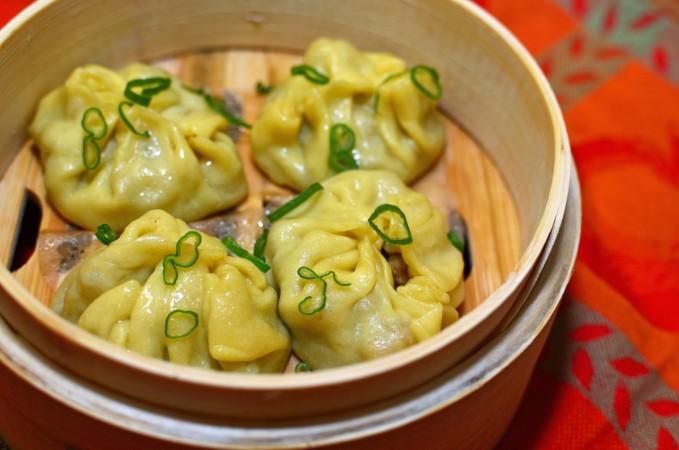
Mongolian Buuz - © Ingmar
Festival and Seasonal Specialties
Boodog
Boodog is a unique Mongolian dish where an entire goat or marmot is roasted from within using hot stones placed inside the animal's cavity. The result is tender, flavorful meat infused with smoky undertones, a testament to Mongolian ingenuity in utilizing local resources. Boodog is a rare delicacy reserved for special occasions and revered for its complexity and bold flavors.
Tsuivan
Tsuivan is a hearty noodle dish stir-fried with meat—typically mutton or beef—alongside vegetables like carrots, onions, and cabbage. Seasoned with soy sauce and other local spices, Tsuivan offers a comforting blend of textures and flavors, making it a popular choice for both everyday meals and festive gatherings.
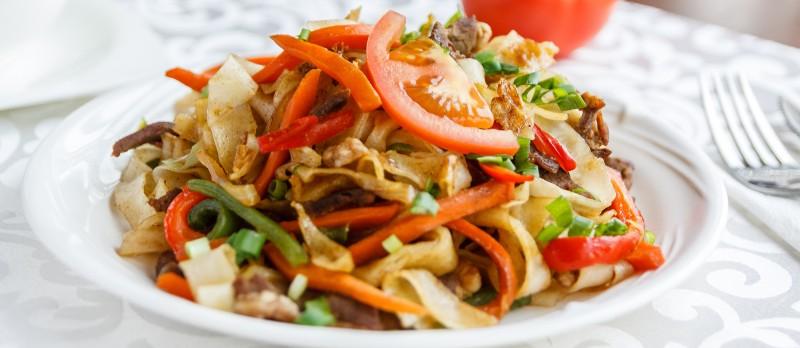
Mongolian Tsuivan - © TasteAtlas
Snacks and Desserts
Bantan
Bantan is a traditional Mongolian dish served during Tsagaan Sar, the Lunar New Year festival. It consists of rice mixed with curd—a type of yogurt—resulting in a creamy and slightly tangy dish that symbolizes prosperity and unity among families. Bantan is often enjoyed alongside other festive foods during this auspicious time of year.
Airag
Airag holds a revered place in Mongolian culture as a traditional fermented beverage made from mare's milk. Known for its nutritional benefits and refreshing taste, Airag is enjoyed throughout Mongolia, particularly during summer months when it offers a cooling respite from the heat. Its slightly sour flavor profile adds a unique dimension to Mongolian culinary experiences.
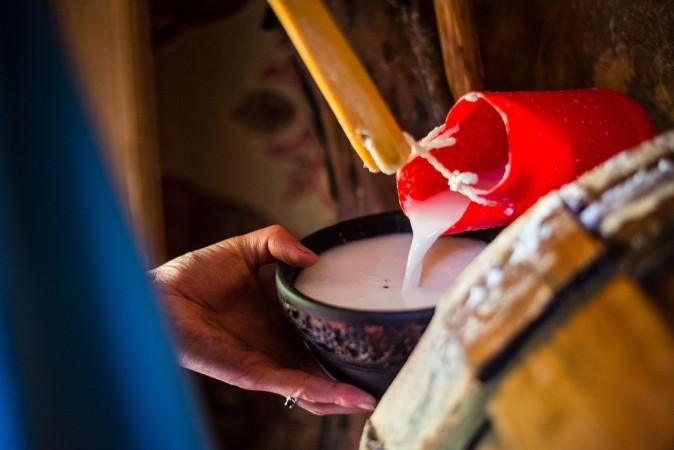
Mongolian Airag - © CNN
Other Notable Delights
Aaruul
Aaruul is a dry curd cheese prepared from fermented milk that is commonly consumed as a snack or dessert in Mongolia. It comes in various shapes and textures, ranging from chewy to brittle, and is cherished for its nutritional value and longevity. Aaruul showcases Mongolia's expertise in dairy products and is a favorite among nomads for its portability and shelf-life.
Bansh
Bansh are small dumplings filled with minced meat and herbs, served either steamed or boiled. They are versatile additions to Mongolian meals, often enjoyed with sauces or as a side dish accompanying main courses. Bansh highlights Mongolia's culinary diversity and is appreciated for their simplicity and satisfying flavors.
Guriltai Shul
Guriltai Shul is a comforting noodle soup featuring meat—typically beef—combined with vegetables and seasoned with local spices. It offers a warm and nourishing experience, perfect for chilly Mongolian winters or as a soothing meal after a day of outdoor adventures.
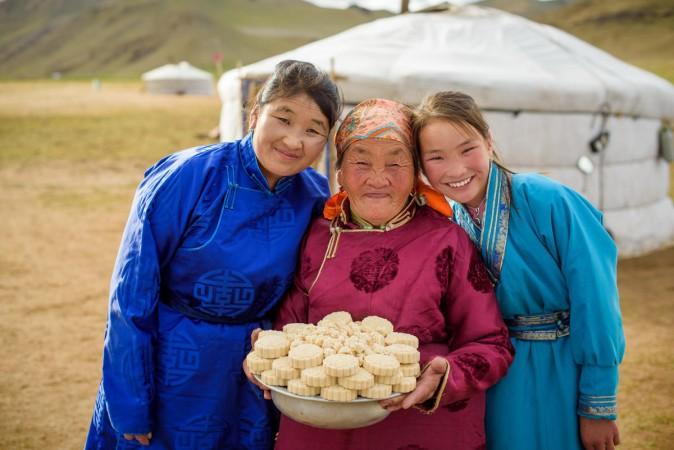
Mongolian Aaruul - © World Vision Singapore
Etiquette at the Mongolian Table
In Mongolia, dining etiquette reflects a deep respect for tradition and hospitality, enriching the dining experience with cultural nuances that every visitor should embrace. When seated at a Mongolian table, it is customary to use your right hand or both hands for taking food, as the left hand traditionally carries connotations of being unclean. This practice extends beyond dining to everyday interactions, such as receiving change at a market, where using the left hand can be perceived as disrespectful.
Moreover, avoid pointing the soles of your shoes towards others, as this gesture is considered impolite in Mongolian culture. It's also important to refrain from leaving the table while others are still eating, as this may disrupt the communal atmosphere cherished during meals. Equally significant is the approach to food offered: it's customary to accept graciously and avoid criticizing any dish, even if it differs from your palate. For instance, salty tea, a common beverage served in Mongolia, should be acknowledged with a sip to show respect for the host's hospitality.
Visiting a Mongolian ger (traditional dwelling) for a meal presents a special opportunity to connect with local customs. Bringing small gifts, particularly for children, such as candies or other edible treats, demonstrates appreciation for the hospitality extended. These gifts are often enjoyed together, with a bottle of good vodka being opened at the meal's conclusion, fostering camaraderie and making the dining experience memorable for both hosts and guests alike.
Understanding and observing these nuances of Mongolian dining etiquette not only enhances cultural immersion but also fosters meaningful connections with local communities. By respecting these traditions, visitors can partake in a dining experience that goes beyond food, embodying the spirit of hospitality and camaraderie that defines Mongolian culture.
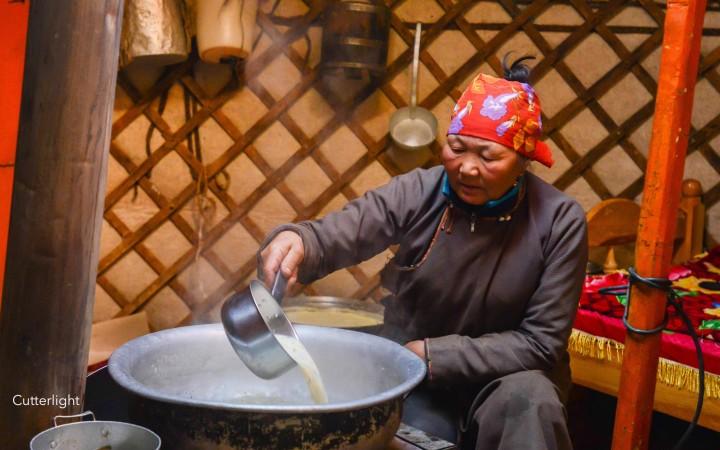
Mongolian Suutei Tsai - © CutterLight
Delicacy of Mongolian Nomadic Culture
Mongolian cuisine is more than just food; it is a journey through history, culture, and the indomitable spirit of nomadic life. From the rugged steppes to the bustling markets of Ulaanbaatar, every dish tells a tale of survival, resourcefulness, and communal bonding. The must-try dishes of Mongolia not only nourish the body but also enrich the soul, offering a taste of tradition amidst some of the world's most breathtaking landscapes.
As you explore Buuz's delicate folds or savor the crispy goodness of Khuushuur, you're participating in a culinary tradition that has sustained Mongolians for centuries. Khorkhog's smoky aroma, infused with the essence of hot stones, transports you to the heart of nomadic gatherings where stories are shared under starlit skies. Each dish, from the festive Boodog to the comforting Tsuivan, invites you to experience Mongolia's rich cultural tapestry through its flavors.
Beyond the dishes themselves, Mongolian cuisine embodies a philosophy of resilience and adaptation to nature's challenges. It celebrates the simplicity of local ingredients and the ingenuity of cooking methods perfected over generations. Whether you're enjoying a bowl of Bantan during Tsagaan Sar or sipping Airag under the summer sun, every bite and sip connects you to Mongolia's vibrant heritage.
As Mongolia welcomes travelers from around the globe, its culinary treasures await discovery. Whether you're planning a trip to experience these dishes firsthand or seeking to recreate Mongolian flavors in your own kitchen, embrace the adventure that awaits. Let the spirit of Mongolia's nomadic traditions and warm hospitality guide your culinary journey, leaving you with memories as rich and enduring as the flavors themselves.
“While Mongolian cuisine may not be as globally renowned as some others, it still holds a special place in Mongolian culture and is enjoyed by people who have had the opportunity to experience it,” said Tumur Amarsanaa, HE Ambassador of Mongolia in an interview with Elite Plus Magazine.
Articles for you

Experience Aboard The RV Indochine II - A Mekong Cruise With Tweet World Travel
The RV Indochine II is a luxury river cruise ship, offering an unforgettable journey through many attractions along the Mekong River. Built in 2017, this upscale vessel combines colonial elegance with modern conveniences to create a comfortable yet stylish environment for its crew and passengers. The ship’s intimate size makes it ideal for those seeking a more personal cruising experience while exploring Vietnam and Cambodia rich culture, scenery, and heritage. Whether you're gazing at the landscape from your private balcony or enjoying authentic local cuisine, RV Indochine II promises an exotic adventure like no other.

Witness Stilt Fishing In Sri Lanka: An Eco-Tourism Experience
Sri Lanka, renowned for its stunning beaches and rich cultural heritage, harbors a unique tradition that has captivated travelers for centuries: stilt fishing. This ancient practice, passed down through generations of coastal communities, blends artistry with necessity, offering a glimpse into a way of life intimately connected to the island's coastal rhythms. Stilt fishing in Sri Lanka isn't merely a means to catch fish; it's a cultural emblem, embodying the resilience and ingenuity of Sri Lanka's fishing communities.

Make Your Trip Stress-Free With The Tweet Trip App
Embark on your next adventure with confidence by downloading the Tweet Trip App, available for both iOS and Android. This essential travel companion allows you to view your detailed itinerary, stay connected with your tour guide and fellow travelers, receive real-time updates, and provide feedback effortlessly. With features like in-app messaging, emergency assistance, and location sharing, the Tweet Trip App ensures you travel smarter, stay connected, and enjoy a seamless, worry-free journey. Get started today and make the most of your travel experience with Tweet World Travel.

Pedal Through Paradise: Unveiling Cambodia's Hidden Gems on Two Wheels
The gentle whir of bicycle wheels mingles with the distant chants of monks as you glide past emerald rice paddies stretching to the horizon. This is Cambodia - a sensory explosion waiting to be experienced on two wheels. At Tweet Tours, we believe there's no better way to immerse yourself in the Kingdom of Wonder than by bicycle.
Cambodia isn't just a destination; it's a living, breathing tapestry of ancient wonders, natural beauty, and vibrant culture. Our carefully crafted cycling tours take you beyond the typical tourist haunts, offering a unique perspective on this captivating country. Ready to clip in and discover the magic of Cambodia? Let's ride!

Trekking in the Himalayas: A Journey Through Nepal's Majestic Peaks
The Himalayas rise from the earth like colossal guardians, their snow-capped peaks piercing the sky in a display of nature's raw power and beauty. Nepal, nestled at the heart of this mountain range, serves as the gateway to some of the most breathtaking trekking experiences on the planet. Here, the air is crisp and thin, filled with the promise of adventure and the whispers of ancient tales.
With Tweet Tours, as you set foot on these hallowed trails, you're not just a traveler - you're a modern-day explorer, following in the footsteps of legendary mountaineers and age-old traders. Each step takes you further into a world where nature reigns supreme and human resilience is tested against the backdrop of some of the world's highest peaks.
From the moment your boots touch the ground in Kathmandu, you'll feel the pull of the mountains. The bustling streets of the capital, with their sensory overload of sights, sounds, and smells, soon give way to serene mountain paths where the only soundtrack is the crunch of gravel underfoot and the distant tinkling of yak bells.

Exploring Mui Ne's Wonders: Unique Attractions & Local Dishes
Nestled along the southeastern coast of Vietnam, Mui Ne emerges as a captivating gem, blending natural wonders with cultural richness. Renowned for its stunning landscapes and unique attractions, Mui Ne beckons travelers seeking both relaxation and adventure in equal measure. Mui Ne's renowned beach dunes, bustling fishing towns, and excellent local food await exploration at every turn.
The allure of Mui Ne lies not only in its pristine beaches and crystal-clear waters but also in its diverse range of activities catering to every traveler's whims. Whether you're drawn to thrilling water sports like kitesurfing and windsurfing on its dynamic shores or seeking tranquility amidst the picturesque Fairy Stream, Mui Ne promises an unforgettable journey filled with discovery.
